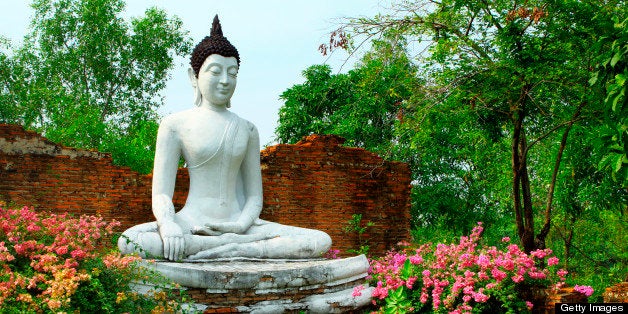
The Buddha's Eightfold Path is typically thought of as an elementary or basic teaching--something taught in Sunday school or in introductory college classes. In this article I am taking the position that the eightfold path is actually an advanced or complete teaching, one that meditation students of Buddhism would do well to study thoroughly. My tradition is Zen¸ which emphasizes meditation, and when I first went to a Zen center to learn meditation, I was taught how to sit and to follow the simple rituals associated with sitting, and little else. Dogen, the 12th century Japanese founder of the Zen tradition I follow, taught his students only to do zazen (Zen meditation) and set aside everything else--precepts, sutras, chanting, everything; just do zazen, he said.
This approach may have made sense in Dogen's Japan where everyone was steeped in Buddhist teachings and values from birth, but since the way of Buddha is relatively new in the West, and will remain so for some time, we should not be so hasty. What the Buddha taught was not a just a set of meditation techniques or a method for inner transformation, but an entire way of life based on awakening. He called this way of life marga, or "path," and patiently laid out the various aspects and qualities of this path in all of his sermons. Meditation is certainly one of the practices Buddha taught (it is the eighth of the eightfold path) but there were many others.
The reason I choose to call the eightfold path an advanced teaching is that, while the definitions of each of the practices are relatively easy to teach and understand, their full application and integration takes a lifetime. My teacher Shunryu Suzuki said that while enlightenment is not unimportant, the deepest practice is the development of character, which he said is a whole life's work and never ends. Character means the kind of human being you are, and the quality of your interactions with other people and the whole of the living world. Enlightenment has little practical value if it is divorced from character. The eightfold path could be seen as a map or guide for the development of character in the light of awakening, and each of the eight practices of the path are equally important; none should be neglected.
The eightfold path is usually translated as a series of "rights": right view, right intention, right action, right speech, right livelihood, right effort, right mindfulness, and right meditation. I am not fond of the word "right" in this context. To my ear there is something self-righteous, judgmental, even arrogant in it, especially when compared with other faiths. I prefer to simply say: Buddhist view, Buddhist intention, and so on. Another possibility is to use the word "awakened": awakened view, awakened intention, and so on. The Sanskrit samma--usually translated as "right"--means correct or appropriate; it doesn't mean right as opposed to wrong. In the Zen tradition there is this story. A monk once asked Chinese Master Ummon, "What is the work of the Buddha's whole life?" Ummon replied, "An appropriate response." Ummon may have been speaking of awakened character--the work of a person's whole life. The person of wisdom responds to each situation appropriately in the light of awakening. That was the Buddha's whole life, Ummon says, and that should be our whole life too.
It is interesting that the practice of meditation has so captured the attention and imagination of the West in its exploration of Buddhism. For most of Buddhism's history, meditation was a practice exclusively reserved for monks and nuns, lifelong ascetics living a cloistered and highly regulated life. Laypeople had no time for meditation; it was hard enough for them simply to survive. Now things are different; in the affluent West both men and women now have the leisure time to explore the treasure of meditation without necessarily giving up their worldly involvements or livelihoods. This is good, but the pursuit of meditation separate from the other seven practices of the eightfold path is prone to lead to an unbalanced character--one that is deep in its experience of the inner life but possibly shallow in other areas such as ethical behavior and kindliness.
I myself spent the first fifteen years of my adult life as a resident monastic, spending long hours each day in the meditation hall, living apart from the world, wearing a shaved head and robes. There came a point when I instinctively rebelled. I sensed that I had lost some basic balance or grounding that I needed to really understand and integrate what I had been doing. I remember asking myself, "I wonder what has happened to the old Lew? I wonder what he would be like if I left this exotic life, got a job, and lived once again like an ordinary person?"
So that's what I did. Now as I look back I think I was instinctively looking for the rest of the eightfold path, the one that leads to a balanced, generous character and an open-hearted response to the tumult and difficulty of ordinary life. In future posts I will explore this contrast further, and investigate, each in turn, the eight practices that the Buddha enumerated as essential for the development and actualization of what the Dalai Lama terms "a sincere human being." When I was young I wanted to be enlightened, utterly transformed. Now that I am older I am content if I can be a sincere human being helping others to be that way too.